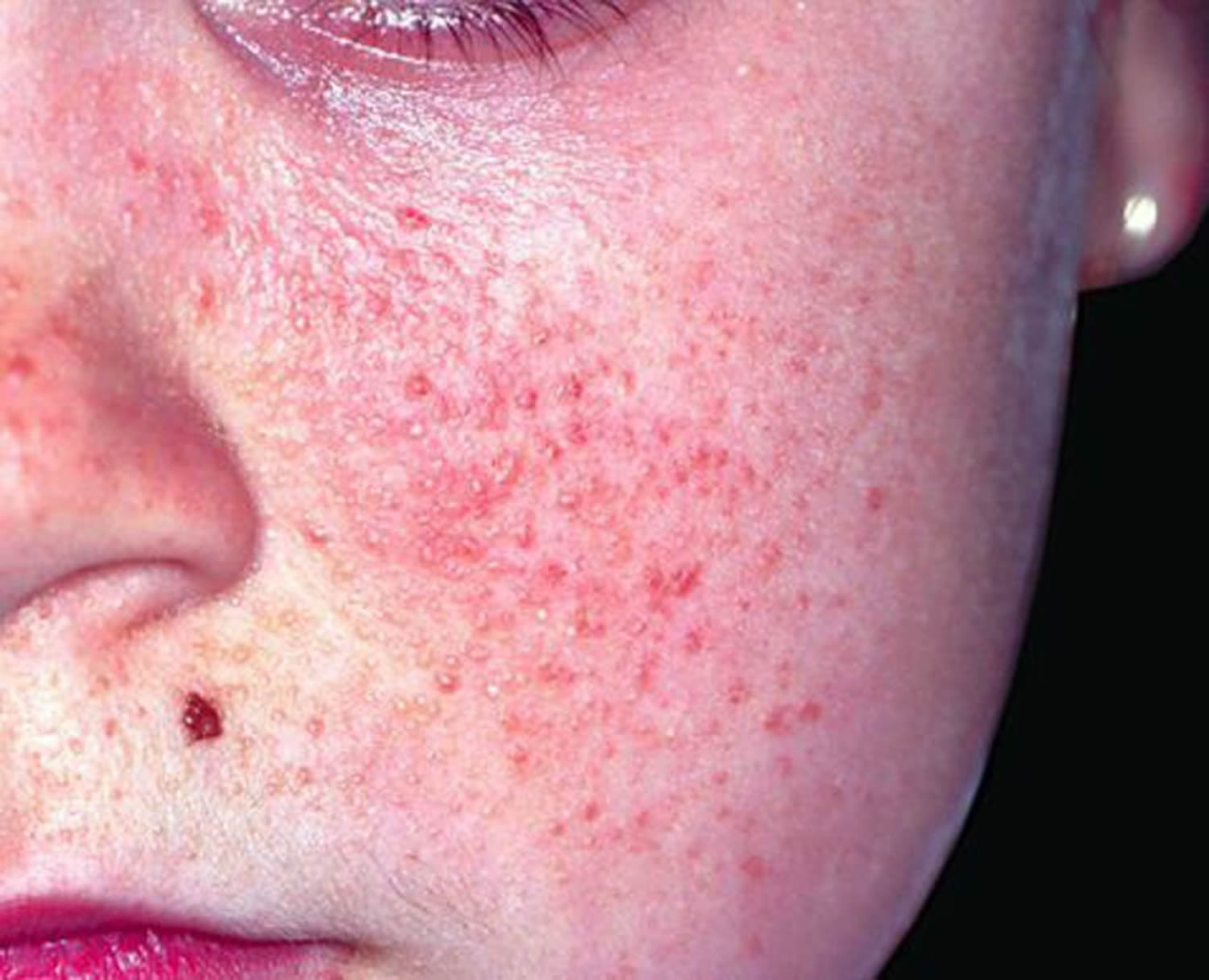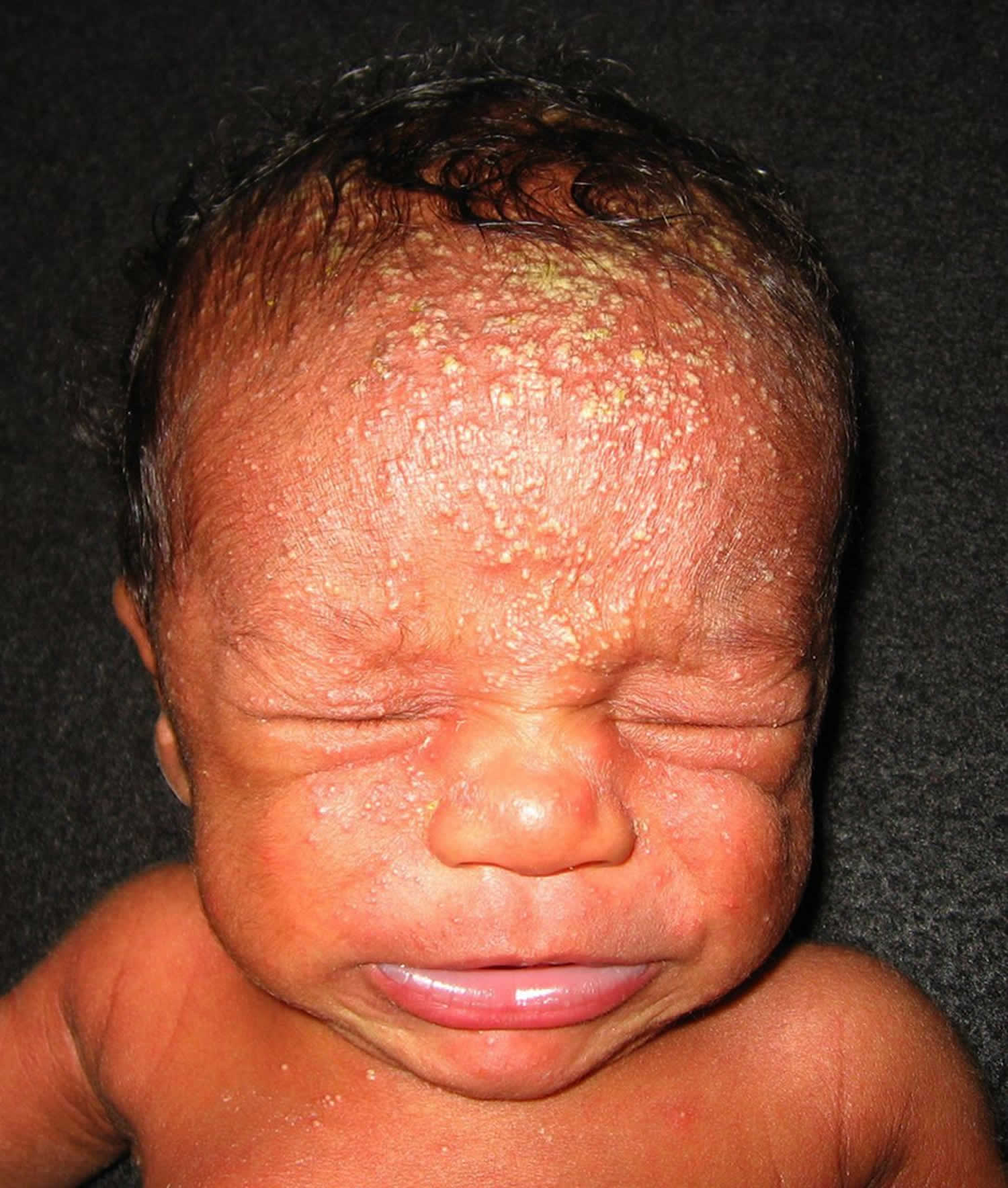What are acneiform eruptions
Acneiform eruptions are a group of dermatoses which are characterized by papules and pustules resembling acne vulgaris (common acne) 1. Acneiform eruptions has an acute onset and can affect any age group. The characteristic acneiform eruptions lesion may be a nodule, papule, pustular or a cyst. The major difference between acne vulgaris (common acne) and acneiform eruptions is that the latter does not have comedones 2. While acne vulgaris (common acne) typically consists of comedones, acneiform eruptions such as acneiform drug eruptions, usually lack comedones clinically. Acneiform eruptions may affect the face and neck. Acnelike eruptions develop as a result of infections, hormonal or metabolic abnormalities, genetic disorders, and drug reactions.
Acneiform eruptions on trunk are described as folliculitis, which may be due to infection, obstruction, or unknown irritant factors. Time course, distribution and appearance may be helpful in making a more accurate diagnosis.
Acneiform eruptions can occur at any age and can affect both genders. Individuals most prone to develop this skin disorder are those who are exposed to bacteria and those who use antibiotics. Acneiform eruptions often develops in hospitalized patients.
Superficial staphylococcal folliculitis is often accompanied by deeper furunculosis (boils) and abscesses. Individual lesions are acute, tender, follicular pustules. Staphylococcal follicular pustules may also be seen in wound infections. In contrast, pustules accompanying impetigo are non-follicular and less symptomatic. Mild infections resolve without treatment, but topical antiseptics / antibiotics or oral flucloxacillin may be required for more troublesome infection. The quiz describes non-staphylococcal folliculitis.
Figure 1. Acneiform eruptions
Footnote: A 3-week-old infant presents with multiple pustules on his face. Lesions have been present for 1 week and do not appear to bother the infant. The child was born via uncomplicated vaginal delivery at 39 weeks. The mother did not receive prenatal care until 22 weeks of pregnancy, when she realized she was pregnant. She is worried that her child might have ‘caught something’ from a sick sibling at home.
[Source 3 ]Acneiform eruptions causes
Acne-like eruptions can develop due to infections, hormonal, or metabolic abnormalities, genetic disorders, drug reactions, contact with chemicals, or from friction and pressure 4.
There are many causes for acneiform eruptions including exposure to halogenated aromatic hydrocarbons and use of antibiotics like macrolides and penicillin. Other drugs that can also induce acneiform eruptions include nystatin, isoniazid, corticotropin, naproxen, and hydroxychloroquine.
Many organisms can also induce acneiform eruptions like infections by Proteus, Klebsiella, Escherichia coli, and Enterobacter. Pityrosporum folliculitis caused by Malassezia furfur may also present on the trunk and upper extremities with pruritic eruptions. Infections which are known to cause acneiform eruptions include secondary syphilis, mycotic infections, cutaneous coccidioidomycosis, and Sporothrix schenckii.
Prolonged and increased excretion of causative substances might irritate the follicular epithelium and produce an inflammatory reaction.
Acneiform eruptions can also be seen in conditions like nevus comedonicus, eruptive hair cysts, and tuberous sclerosis.
Acneiform acne can be classified into the following:
Drug-induced acne
This acne can occur due to corticosteroids, anticonvulsants like phenytoin, antidepressants, the antipsychotics olanzapine and lithium, antituberculosis drugs like INH, thiourea, thiouracil, disulfiram, corticotropin, antifungals like nystatin and itraconazole, hydroxychloroquine, naproxen, mercury, amineptine, chemotherapy drugs, and epidermal growth factor receptor inhibitors.
Antibiotics like penicillins and macrolides cause acute generalized pustular eruption without comedones. Patients are febrile with leukocytosis, Other antibiotics causing it include co-trimoxazole, doxycycline, ofloxacin, and chloramphenicol.
Steroid acne presents as monomorphous papulopustules located mainly on the trunk and extremities, with less involvement of the face. Characteristically, lesions appear after the administration of systemic corticosteroids. Topical corticosteroids may also cause acneiform eruption over skin under which the topical preparation is applied or in around the nose or mouth in the case of inhaled steroids.
Occupational acne
Due to occupational exposure from Chloracne. Chloraphthalene, chlorophenyl (used as conductors and insulator), and chlorophenols (used as insecticide and fungicide) can cause acneiform eruptions. Lesions are mainly comedones without inflammation. Exposure by inhalation, ingestion, or direct contact of contaminated compounds or foods induces a cutaneous eruption of polymorphous comedones and cysts which is called as chloracne. Associated skin findings include xerosis, and pigmentary changes are also seen. Internal organs like eyes, central nervous system and liver may also be affected. Some chloracnegens can be oncogenic.
Chemicals that contain iodides, bromides, and other halogens can also induce an acneiform eruption similar to steroid acne, but iodide-induced eruption are more severe. All patients should be investigated for ophthalmic, neurologic, hepatic, and lipoprotein abnormalities.
Chemical acne
Chemical like heavy oils, waxes, cutting oils, heavy coal tar derivatives like pitch and creosote, vegetable oil in cosmetics, and cheap pomade oils causes acneiform eruptions.
Mechanical acne
Pressure and friction induce acneiform eruptions over the neck of violin players, under arm bands, bra straps and in orthopedic cases prolonged immobilization.
Eosinophilic pustular folliculitis is a disease of allergic hypersensitivity. It appears as a recurrent pruritic papulopustular eruption on the face, trunk, and extremities.
Rosacea appears similar to acne vulgaris with papulopustules on the face but also has facial flushing and telangiectasias. Is commonly seen in the white population. It is more common in women in the third and fourth decades of life. Associated eye changes include blepharitis, conjunctivitis, iritis, iridocyclitis, hypopyon iritis, and keratitis. Weather extremes, hot or spicy foods, alcohol, ingestion of a high-dose vitamin B6 and Demodex folliculorum mites can trigger the condition.
Acneiform eruptions symptoms
Papules, pustules with the absence of true comedones, are present mainly over trunk and back. Rarely nodulocystic lesions can be seen. Unlike acne, these lesions may occur in other parts of the body besides the face. When the cause is due to a drug eruption, the patient will usually state that the lesions disappear once they discontinue the medication.
Acneiform eruptions diagnosis
The lesions of acneiform folliculitis look similar to acne but lack comedones. Rarely, a biopsy is done, but when performed results may reveal the presence of fungi or bacteria. There is evidence of mild inflammation with the presence of both neutrophils and eosinophils.
Acneiform eruptions can be distinguished from common acne (acne vulgaris) by a history of sudden onset, monomorphic morphology, development of the eruption at any age, affecting trunk more common than the face, not necessarily affecting sebaceous areas of the body with a rarity of cyst formation. In most cases, the diagnosis is clinical, but when there is doubt about the diagnosis, one may obtain a biopsy or culture any discharge. Withdrawal of the suspected medication is another way to make the diagnosis 5.
Acneiform eruptions treatment
The treatment of acneiform eruptions depends on the cause. In most cases, if the cause is an organism or a drug, then the exposure should be discontinued. Most patients recover within a few weeks. For any residual lesions, treatments that have been used to treat acneiform eruptions include laser ablation, excision, topical or oral antibiotics, drug withdrawal or use of topical or oral retinoids. If the cause is a fungal infection like pityrosporum folliculitis, then the use of a topical antifungal agent can be helpful like ciclopirox, econazole, and ketoconazole can be helpful 6.
Treatment of chloracne is difficult as it may persist for years, even without further exposure.
Some patients with eosinophilic pustular folliculitis may benefit from a short course of oral indomethacin. Lesions that fail to respond to indomethacin may be treated with cyclosporine.
The traditional agents used to treat acne vulgaris seldom work in patients with acneiform eruptions, but one may suggest the use of skin cleaners like salicylic acid or benzoyl peroxide to reduce the oily skin.
Itching is a very common symptom in patients with acneiform eruptions so that these patients may benefit from the use of antihistamines. If the itching is nocturnal, first-generation antihistamines are recommended because they also induce sleep.
There are some cases of acneiform eruptions that may benefit from the use of dapsone. Anecdotal reports indicate that eosinophilic pustular eruptions do respond to a short course of dapsone.
Patients who have gram-positive organisms causing the skin lesions may also benefit from doxycycline.
Over the years, the use of retinoids to treat acneiform eruptions has increased with success. Both oral and topical retinoids have been used. These agents are known to decrease the production of sebum and rapidly resolve the eruptions. These agents should not be prescribed to women of childbearing age because of their teratogenic potential.
Avoid the causative drug in drug-induced acne. Minimize contacts or friction which will prevent occupational and mechanical acne. Protective clothing and removal of the worker from unsuitable environment also help.
References- Nair PA, Salazar FJ. Acneiform Eruptions. [Updated 2018 Dec 2]. In: StatPearls [Internet]. Treasure Island (FL): StatPearls Publishing; 2019 Jan-. Available from: https://www.ncbi.nlm.nih.gov/books/NBK459207
- Gupta M, Aggarwal M, Bhari N. Acneiform eruptions: An unusual dermatological side effect of ribavirin. Dermatol Ther. 2018 Sep;31(5):e12679
- Lio PA, Lee KC. Acneiform eruptions. Archives of Disease in Childhood – Education and Practice 2013;98:126-127.
- Musthaq S, Mazuy A, Jakus J. The microbiome in dermatology. Clin. Dermatol. 2018 May – Jun;36(3):390-398.
- Del Rosso JQ. Who Is Accountable When Patients Do Not Achieve Successful Treatment for Their Acne? J Drugs Dermatol. 2018 Jun 01;17(6):599-600.
- Truitt JM, Reichenberg JS, Sharghi KG, Sampson SM, Roenigk RK, Magid M. Isotretinoin: the ups are just as troubling as the downs. G Ital Dermatol Venereol. 2018 Aug;153(4):535-539.






